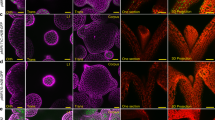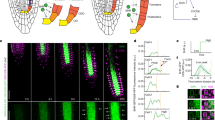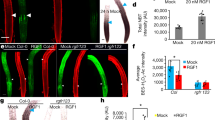Abstract
Changes in gene regulation during differentiation are governed by networks of transcription factors. The Arabidopsis root endodermis is a tractable model to address how transcription factors contribute to differentiation. We used a bottom-up approach to understand the extent to which transcription factors that are required for endodermis differentiation can confer endodermis identity to a non-native cell type. Our results show that the transcription factors SHORTROOT and MYB36 alone have limited ability to induce ectopic endodermal features in the absence of additional cues. The stele-derived signalling peptide CIF2 stabilizes SHORTROOT-induced endodermis identity acquisition. The outcome is a partially impermeable barrier deposited in the subepidermal cell layer, which has a transcriptional signature similar to the endodermis. These results demonstrate that other root cell types can be forced to differentiate into the endodermis and highlight a previously unappreciated role for receptor kinase signalling in maintaining endodermis identity.
This is a preview of subscription content, access via your institution
Access options
Access Nature and 54 other Nature Portfolio journals
Get Nature+, our best-value online-access subscription
$29.99 / 30 days
cancel any time
Subscribe to this journal
Receive 12 digital issues and online access to articles
$119.00 per year
only $9.92 per issue
Buy this article
- Purchase on Springer Link
- Instant access to full article PDF
Prices may be subject to local taxes which are calculated during checkout






Similar content being viewed by others
References
Takahashi, K. & Yamanaka, S. A decade of transcription factor-mediated reprogramming to pluripotency. Nat. Rev. Mol. Cell Biol. 17, 183–193 (2016).
Pillitteri, L. J., Sloan, D. B., Bogenschutz, N. L. & Torii, K. U. Termination of asymmetric cell division and differentiation of stomata. Nature 445, 501–505 (2006).
Gallois, J.-L., Nora, F. R., Mizukami, Y. & Sablowski, R. WUSCHEL induces shoot stem cell activity and developmental plasticity in the root meristem. Genes Dev. 18, 375–380 (2004).
Davidson, E. H., McClay, D. R. & Hood, L. Regulatory gene networks and the properties of the developmental process. Proc. Natl Acad. Sci. USA 100, 1475–1480 (2003).
Drapek, C., Sparks, E. E. & Benfey, P. N. Uncovering gene regulatory networks controlling plant cell differentiation. Trends Genet. 33, 529–539 (2017).
Geldner, N. The endodermis. Annu. Rev. Plant Biol. 64, 531–558 (2013).
Andersen, T. G., Barberon, M. & Geldner, N. Suberization—the second life of an endodermal cell. Curr. Opin. Plant Biol. 28, 9–15 (2015).
Nakajima, K., Sena, G., Nawy, T. & Benfey, P. N. Intercellular movement of the putative transcription factor SHR in root patterning. Nature 413, 307–311 (2001).
Helariutta, Y. et al. The SHORT-ROOT gene controls radial patterning of the Arabidopsis root through radial signaling. Cell 101, 555–567 (2000).
Di Laurenzio, L. et al. The SCARECROW gene regulates an asymmetric cell division that is essential for generating the radial organization of the Arabidopsis root. Cell 86, 423–433 (1996).
Liberman, L. M., Sparks, E. E., Moreno-Risueno, M. A., Petricka, J. J. & Benfey, P. N. MYB36 regulates the transition from proliferation to differentiation in the Arabidopsis root. Proc. Natl Acad. Sci. USA 112, 12099–12104 (2015).
Kamiya, T. et al. The MYB36 transcription factor orchestrates Casparian strip formation. Proc. Natl Acad. Sci. USA 112, 10533–10538 (2015).
Roppolo, D. et al. A novel protein family mediates Casparian strip formation in the endodermis. Nature 473, 380–383 (2012).
Pfister, A. et al. A receptor-like kinase mutant with absent endodermal diffusion barrier displays selective nutrient homeostasis defects. eLife 3, e03115 (2014).
Moreno-Risueno, M. A. et al. Transcriptional control of tissue formation throughout root development. Science 350, 426–430 (2015).
Doblas, V. G. et al. Root diffusion barrier control by a vasculature-derived peptide binding to the SGN3 receptor. Science 355, 280–284 (2017).
Nakayama, T. et al. A peptide hormone required for Casparian strip diffusion barrier formation in Arabidopsis roots. Science 355, 284–286 (2017).
Sena, G., Jung, J. W. & Benfey, P. N. A broad competence to respond to SHORT ROOT revealed by tissue-specific ectopic expression. Development 131, 2817–2826 (2004).
Lee, M. M. & Schiefelbein, J. WEREWOLF, a MYB-related protein in Arabidopsis, is a position-dependent regulator of epidermal cell patterning. Cell 99, 473–483 (1999).
Siligato, R. et al. MultiSite Gateway-compatible cell type-specific gene-inducible system for plants. Plant Physiol. 170, 627–641 (2016).
Barberon, M. et al. Adaptation of root function by nutrient-induced plasticity of endodermal differentiation. Cell 164, 447–459 (2016).
Alassimone, J., Naseer, S. & Geldner, N. A developmental framework for endodermal differentiation and polarity. Proc. Natl Acad. Sci. USA 107, 5214–5219 (2010).
Wu, S. et al. A plausible mechanism, based upon SHORT-ROOT movement, for regulating the number of cortex cell layers in roots. Proc. Natl Acad. Sci. USA 111, 16184–16189 (2014).
Brady, S. M. et al. A high-resolution root spatiotemporal map reveals dominant expression patterns. Science 318, 801–806 (2007).
Efroni, I., Ip, P.-L., Nawy, T., Mello, A. & Birnbaum, K. D. Quantification of cell identity from single-cell gene expression profiles. Genome Biol. 16, 9 (2015).
Li, S., Yamada, M., Han, X., Ohler, U. & Benfey, P. N. High-resolution expression map of the Arabidopsis root reveals alternative splicing and lincRNA regulation. Dev. Cell 39, 508–522 (2016).
Chezem, W. R., Memon, A., Li, F.-S., Weng, J.-K. & Clay, N. K. SG2-type R2R3-MYB transcription factor MYB15 controls defense-induced lignification and basal immunity in Arabidopsis. Plant Cell 29, 1907–1926 (2017).
Masucci, J. D. et al. The homeobox gene GLABRA2 is required for position-dependent cell differentiation in the root epidermis of Arabidopsis thaliana. Development 122, 1253–1260 (1996).
Brady, S. M., Song, S., Dhugga, K. S., Rafalski, J. A. & Benfey, P. N. Combining expression and comparative evolutionary analysis. The COBRA gene family. Plant Physiol. 143, 172–187 (2007).
Clark, N. M. et al. Tracking transcription factor mobility and interaction in Arabidopsis roots with fluorescence correlation spectroscopy. eLife 5, e14770 (2016).
Scheres, B. Plant cell identity. The role of position and lineage. Plant Physiol. 125, 112–114 (2001).
Long, Y. et al. Arabidopsis BIRD zinc finger proteins jointly stabilize tissue boundaries by confining the cell fate regulator SHORT-ROOT and contributing to fate specification. Plant Cell 27, 1185–1199 (2015).
Enstone, D. E., Peterson, C. A. & Ma, F. Root endodermis and exodermis: structure, function, and responses to the environment. J. Plant Growth Regul. 21, 335–351 (2002).
Kurihara, D., Mizuta, Y., Sato, Y. & Higashiyama, T. ClearSee: a rapid optical clearing reagent for whole-plant fluorescence imaging. Development 142, 4168–4179 (2015).
Ursache, R., Andersen, T. G., Marhavý, P. & Geldner, N. A protocol for combining fluorescent proteins with histological stains for diverse cell wall components. Plant J. 93, 399–412 (2018).
Malamy, J. E. & Benfey, P. N. Organization and cell differentiation in lateral roots of Arabidopsis thaliana. Development 124, 33–44 (1997).
Birnbaum, K. et al. Cell type-specific expression profiling in plants via cell sorting of protoplasts from fluorescent reporter lines. Nat. Methods 2, 615–619 (2005).
Robinson, M. D., McCarthy, D. J. & Smyth, G. K. edgeR: a Bioconductor package for differential expression analysis of digital gene expression data. Bioinformatics 26, 139–140 (2009).
Acknowledgements
We thank the Duke University Genome Sequencing and Analysis Core for sequencing the RNA libraries. We thank I. Efroni for assistance in the ICI pipeline and G. Wachsmann for assistance in mapping RNA-seq reads. We are also grateful to N. Clark and R. Sozzani for assistance with the paired correlation function technique. We thank the Duke Light Microscopy Facility and R. Ursache for assistance in microscopy, members of the Benfey lab for comments on the manuscript, V. G. Doblas for assistance with the CIF2 treatments, H. Belcher and J. Zhang for technical assistance and K. Gallagher for thoughtful discussion. This research was funded by grants from the NIH (R01-GM043778) and the Howard Hughes Medical Institute and the Gordon and Betty Moore Foundation (GBMF3405) to P.N.B. N.G. was funded by an ERC Consolidator Grant (GA-no. 616228—ENDOFUN) and an SNSF grant (31003A_156261). Additional support was provided to C.D. through an EMBO short-term fellowship, to E.E.S. through startup funds from the University of Delaware, to P.M. by a FEBS long-term fellowship and to T.G.A. by an IEF Marie Curie fellowship.
Author information
Authors and Affiliations
Contributions
C.D., P.N.B. and N.G. designed the experiments. C.D. and P.N.B. wrote the manuscript. C.D. carried out the CIF2 treatments, barrier assays, FDA assays, staining/clearing, cell sorting and RNA-seq preparation. C.D., E.E.S. and I.T. carried out the RNA-seq analyses. C.D. and P.M. carried out the live-imaging experiments. C.D., T.G.A. and J.H.H. generated the transgenic lines. All authors contributed to the discussion and interpretation of results.
Corresponding author
Ethics declarations
Competing interests
The authors declare no competing interests.
Additional information
Publisher’s note: Springer Nature remains neutral with regard to jurisdictional claims in published maps and institutional affiliations.
Supplementary information
Supplementary Information
Supplementary Figures 1–15 and Supplementary Video legends.
Supplementary Table 1
Differentially expressed genes and CPMs of CIF2 treated FACS samples.
Supplementary Table 2
Index of Cell Identity results and statistics.
Supplementary Table 3
Differentially expressed genes and CPMs of CIF2 treated whole root samples.
Supplementary Table 4
Paired Correlation Function analysis and statistics.
Supplementary Table 5
Ectopic CASP1 intensity measurements.
Supplementary Table 6
Sequencing mapping statistics.
Supplementary Table 7
Cell counting and statistical analysis.
Supplementary Table 8
Sequences of cloning primers.
Supplementary Video 1
FDA penetration of pWER::SHR-GFP without CIF2. Sum projections of live imaging of FDA application to pWER::SHR-GFP roots without CIF2 treatment. Scale bars, 50 μm. Time after FDA addition is indicated at the top left.
Supplementary Video 2
FDA penetration of pWER::SHR-GFP with CIF2. Sum projections of live imaging of FDA application to pWER::SHR-GFP roots treated with CIF2. Scale bars, 50 μm. Time after FDA addition is indicated at the top left.
Supplementary Video 3
Dynamics of ectopic CASP1-mCherry in pWER::SHR-GFP over time. Maximum projection of CASP1-mCherry (gray channel). Scale bar, 50 μm, time elapsed indicated in bottom right.
Supplementary Video 4
Stability of ectopic CASP1-mCherry in pWER::SHR-GFP over after removing CIF2. Maximum projection of CASP1-mCherry (gray channel). Scale bar, 25 μm, time after removing CIF2 indicated in bottom right.
Supplementary Video 5
Effect of CIF2 on CASP1-mCherry in differentiated cells of pWER::SHR-GFP. Maximum projections of CASP1-mCherry (yellow channel) in differentiated cells of pWER::SHR-GFP. Scale bar, 50 μm, time after adding CIF2 indicated in bottom right.
Rights and permissions
About this article
Cite this article
Drapek, C., Sparks, E.E., Marhavy, P. et al. Minimum requirements for changing and maintaining endodermis cell identity in the Arabidopsis root. Nature Plants 4, 586–595 (2018). https://doi.org/10.1038/s41477-018-0213-y
Received:
Accepted:
Published:
Issue Date:
DOI: https://doi.org/10.1038/s41477-018-0213-y



